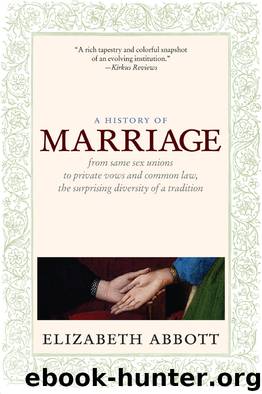A History of Marriage by Elizabeth Abbott

Author:Elizabeth Abbott [Abbott, Elizabeth]
Language: eng
Format: epub
ISBN: 978-1-60980-085-7
Publisher: Seven Stories Press
Published: 2011-08-22T16:00:00+00:00
DIVORCE AT THE DAWN OF THE TWENTIETH CENTURY
Until World War I, Canada remained hostile to divorce. Only Nova Scotia, New Brunswick, and British Columbia had the divorce courts recommended by England, and they almost never granted divorces for any reason other than adultery. In the period between the world wars, Alberta, Saskatchewan, and Ontario established divorce courts. People from other provinces still had to seek divorce through Parliament, an exercise that was expensive, complicated, and public, and one that could be so humiliating, especially to women, that many chose instead to live as fake spinsters, or “grass widows.” Instead of divorcing, many unhappy couples simply separated, legally or informally. Some moved away and remarried, hoping their bigamy would remain undetected. Others settled for American divorces, which, though not legally binding in Canada, seemed as close to real divorce as possible.
The question of “migratory” divorces remained corrosive, as ersatz residents who divorced and then resumed residence in their home state or province were, in effect, importing forbidden divorces they then tried to get validated. This was true of both Americans and Canadians.
As they had in other wars, divorce rates escalated after World Wars I and II. Before the wars, divorce laws throughout the Western world were being liberalized, and divorce was a divisive and hotly debated social issue. In England, the average annual number of divorces rose from 701 between 1907 and 1913, to 2,740 in the years 1918 to 1921. In the United States, there was an average annual increase of 40 percent from 1914 to 1921. Canada continued to maintain a low divorce rate, largely because divorce was so difficult to obtain. Women won the right to sue for divorce on terms of equality with men only in 1925. Ontario, the largest province, established divorce courts only in 1930.
The divorce rates associated with the world wars rose for the usual reasons: a frenzied milieu that speeded up notions of life and death and pushed many people to marry on the spur of the romantic, patriotic moment; enforced separation; and widespread wartime adultery by both soldiers and their wives. But spouses waited to reunite at war’s end before they divorced, so wartime divorce rates declined. With peace, however, came divorce, and the more people divorced, the less unacceptable divorce became.
The abdication crisis of 1936 reinforced Canada’s reluctance to relax its divorce laws. King Edward VIII had fallen in love with a twice-divorced American, Wallis Simpson, and in seeking a constitutional way to marry her, he requested the approval of the British Parliament and all the dominions. But the British public and the Church of England strongly disapproved, and so did Canadians. “Canada is the most puritanical part of the Empire,” an official British report declared. “Canadian pride has been deeply wounded by the tattle in the American press, which she feels an intolerable impertinence.”48
The press gossip was fierce. Wallis Simpson might not even be really divorced from husband #1, at least in England, where the Church of England did not recognize the American grounds of emotional incompatibility.
Download
This site does not store any files on its server. We only index and link to content provided by other sites. Please contact the content providers to delete copyright contents if any and email us, we'll remove relevant links or contents immediately.
| Codependency | Conflict Management |
| Dating | Divorce |
| Friendship | Interpersonal Relations |
| Love & Loss | Love & Romance |
| Marriage | Mate Seeking |
The 5 Love Languages: The Secret to Love That Lasts by Gary Chapman(9518)
Doing It: Let's Talk About Sex... by Hannah Witton(9151)
Should I Stay or Should I Go? by Ramani Durvasula(7518)
The Road Less Traveled by M. Scott Peck(7475)
The Lost Art of Listening by Michael P. Nichols(7360)
Daring Greatly by Brene Brown(6369)
Beartown by Fredrik Backman(5548)
We Need to Talk by Celeste Headlee(5499)
Men In Love by Nancy Friday(5114)
The Rules Do Not Apply by Ariel Levy(4789)
The State of Affairs by Esther Perel(4588)
How To Win Friends and Influence People by Dale Carnegie(4405)
Reflections Of A Man by Mr. Amari Soul(4209)
Pillow Thoughts by Courtney Peppernell(4173)
The Ethical Slut by Janet W. Hardy(4147)
Algedonic by r.h. Sin(3982)
He's Just Not That Into You by Greg Behrendt & Liz Tuccillo(3806)
I Love You But I Don't Trust You by Mira Kirshenbaum(3776)
Finding My Forever by Heidi McLaughlin(3731)
